Tanaka Kazuyuki Hamono
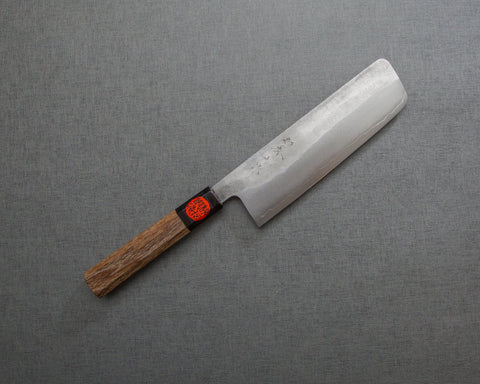
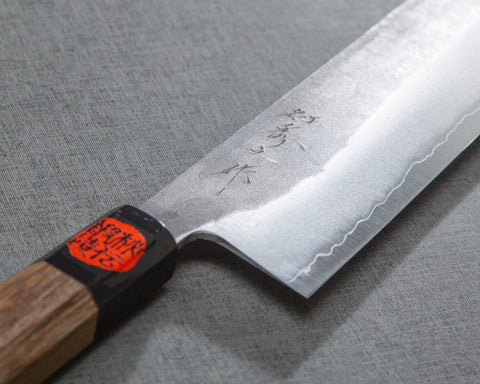
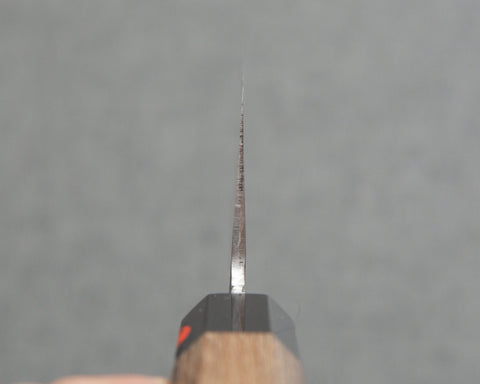
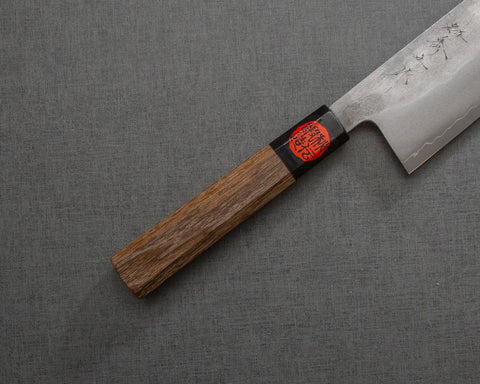
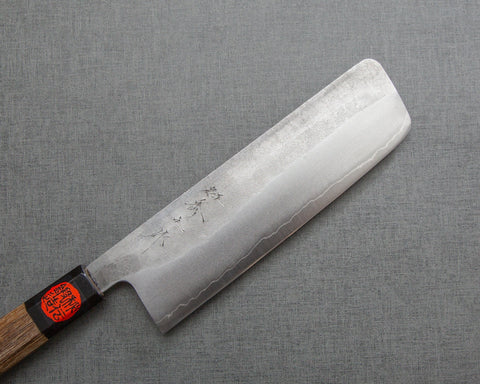
Shigeki Tanaka Ginsan (Silver #3) Nashiji 165mm Nakiri
Pickup currently unavailable
This Tanaka Nakiri is handcrafted by Master Shigeki Tanaka using Ginsan (Silver #3) stainless carbon steel as core, clad in stainless steel, with a beautiful Kasumi line and aesthetically pleasing Nashiji finish. The beautiful edge geometry ensures a very smooth cutting performance, and the wenge wood octagonal handle with a buffalo horn kuchiwa ensures a more balanced handling experience.
Spec:
- Origin (Made in): Miki, Hyogo Prefecture, Japan
- Brand: Tanaka Kazuyuki Hamono
- Craftsman: Shigeki Tanaka
- Knife Type: Nakiri
- Blade
- Construction: San Mai
- Grind: Double-edged Blade (50/50 Grind)
- Hagane (Core Steel): Ginsan (Silver #3)
- Jigane (Cladding): Stainless Steel
- Hardness: 60-61 HRC
- Hand-forged, hand-grinded, hand-sharpened
- Blade Finishes:
- Nashiji
- Kasumi Polish
- Blade Length: 165mm (6.5")
- Blade Height (at heel): 50mm
- Spine Thickness
- Above heel: 2.6mm
- Middle: 2.4mm
- Handle
- Shape: Hachikaku (Octagonal)
- Material: Teak
- Kuchiwa: Black Buffalo Horn
- Length: 128mm
- Overall Length: 310mm
- Weight: 147g (5.19oz)
- Hand chiseled mark: In Japanese Kanji "Craftsman Hideyuki's Work" (名匠 秀之作)
About Tanaka Kazuyuki Hamono 田中一之刃物
Tanaka's blade making started in the late Meiji era in 1904, by making sickles during the Russo-Japanese War. In 1946, Tanaka workshop started focusing more on kitchen knives, and in the year 2000 with the 3rd generation Kazuyuki Takana (田中 一之) on the throne, the family business changed its name to "Tanaka Kazuyuki Hamono" and has been using this name since. Kazuyuki's son - 4th generation blacksmith Shigeki Tanaka (田中 誠貴) - started making blades with his father in 1994. The father and son team, having learned traditional blade making in Fukui, started making knives with "Shigeki saku" and “Hideyuki saku” mark.
Care:
Ginsan (Gin3 or Silver #3) is stainless carbon steel, with 14% added Chromium. Retaining the character of Japanese carbon steel, with a similar hardness of Shirogami #2, Ginsan is stainless. Its edge retention is only slightly inferior to Shirogami #2, but the fact that it combines ease of sharpening, carbon steel character as well being stainless makes it a great choice for those who wish to have a Japanese carbon steel knife that is easy to maintain.
Cutting Surface:
Recommended cutting surface: wood, rubberized boards and high-end composites, and quality plastics such as polyethylene make acceptable cutting surfaces, and will help protect and prolong knife’s edge. AVOID glass, metal, countertops, and other rigid, non-forgiving surfaces.
Sharpening:
We recommend sharpening all quality Japanese knives on whetstones, as we believe they yield the best results for your knives.
The combination of extreme edge thinness combined with the extra blade weight gives this knife an extremely satisfying cutting experience.
I work in a professional kitchen and after multiple hours of straight use I have no complaints about the fit and finish.
Great knife out the box came with a burr so most likely sharpened prior to shipping. No chips . The knife isn’t completely flat there is an angle at approximately 2/3 the length of the knife which can be altered with light work as aforementioned in other reviews. I’ve kept the angle as is to allow for low rocking veggies .
This is NOT a meat knife even though some people demonstrate cutting small fillets due to sharpness. Veggies only and fruit. This isn’t a true carbon steel so you’ll get away with acidic items.
Maintenance is the best part of ginsan because it acts like a carbon steel in sharpness but can be maintained as a stainless. I’m lazy and will mainly sharpen my knife as necessary but I don’t wipe between cuts. I will only do that with a Deba which are hard to find in Ginsan. Nakiri can get expensive so this was the right price point for me without going over budget.
I would say for a beginner nothing more than $200 with tax and shipping . Once you’re used to a few years of blade maintaining then opt for shirogami which isn’t as meticulous as aogami. Also for veggies your blade needn’t be razor sharp as for cutting meat unless you’re doing designs then opt for an usuba.
Free Shipping
Free Shipping on most orders.
30 Days Return
Return unused within 30 days for a full refund, no questions asked (terms apply).
Top Japanese Makers
All knives made in Japan by top Japanese knife makers.
About
Burrfection Store sources professionally designed sharpening products, and knives from top Japanese craftsmen.


